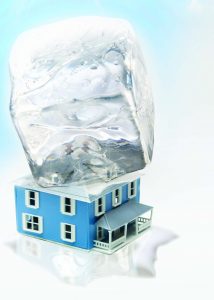
Photos by Getty Images plus/Digital composite by Richard G. Biever
During the summer, the best way to cool down your beverage is to put a few pieces of ice in it. Soon, an even bigger chunk of ice could be responsible for cooling down your home as well! Sound weird? Well, many commercial buildings are already using ice-based technology to do just that.
Ice-chilling your building, properly known as cool thermal storage (CTS), operates under a fairly simple principle: Make a lot of ice during the night, then use that ice during the day instead of an AC compressor to keep the building cool.
This method for air conditioning can shift 95 percent of the energy air conditioning uses from the daytime to nighttime when the ice is made. This is a big benefit to utilities because electricity is almost always in more demand during the day than at night. They pass this demand down to their commercial customers by making them pay more for using a lot of electricity at once. By moving electricity use from daytime to nighttime, both the utility and commercial customer are able to save money.
How can homeowners benefit from this technology? There are several potential benefits.
At least one CTS company, Ice Energy that makes the Ice Bear, developed a residential version of its commercial technology that is already being deployed in California (with plans to expand nationwide later this year). However, only consumers with a time-of-use rate or a demand charge will have an economic incentive to install a CTS system on their home.
By moving electricity use from daytime to nighttime, both the utility and commercial customer are able to save money.
Many electric co-ops do have a special time-of-use rate that was developed specifically for electric thermal storage units in the winter. It’s a similar concept: Use the plentiful electricity at night at an off-peak rate to heat bricks with electric resistance heat. And use just blowers during the day to circulate the heat given off by the bricks that they absorbed the night before.
Even without a special rate, there are still two other benefits of CTS. First, when electric cooperatives save money, so do their members. Second, thermal storage technologies like this help to enable more renewable energy generation on the grid. Wind turbines often produce more energy at night, so shifting more loads to the evening enables the grid to add more wind energy.
CTS technology can be added to existing buildings or built in from the get-go, but there are important considerations for this technology, predominantly around climate and structural integrity. CTS products work best in areas with a high air conditioning load and often need to be installed on top of the building they’ll serve. This means the building’s roof needs to be able to handle several thousand additional pounds; it takes a lot of ice to keep a building cool!
Story by THOMAS KIRK, an associate analyst of distributed energy resources for the Arlington, Virginia-based National Rural Electric Cooperative Association’s Business & Technology Strategies (BTS) division.



